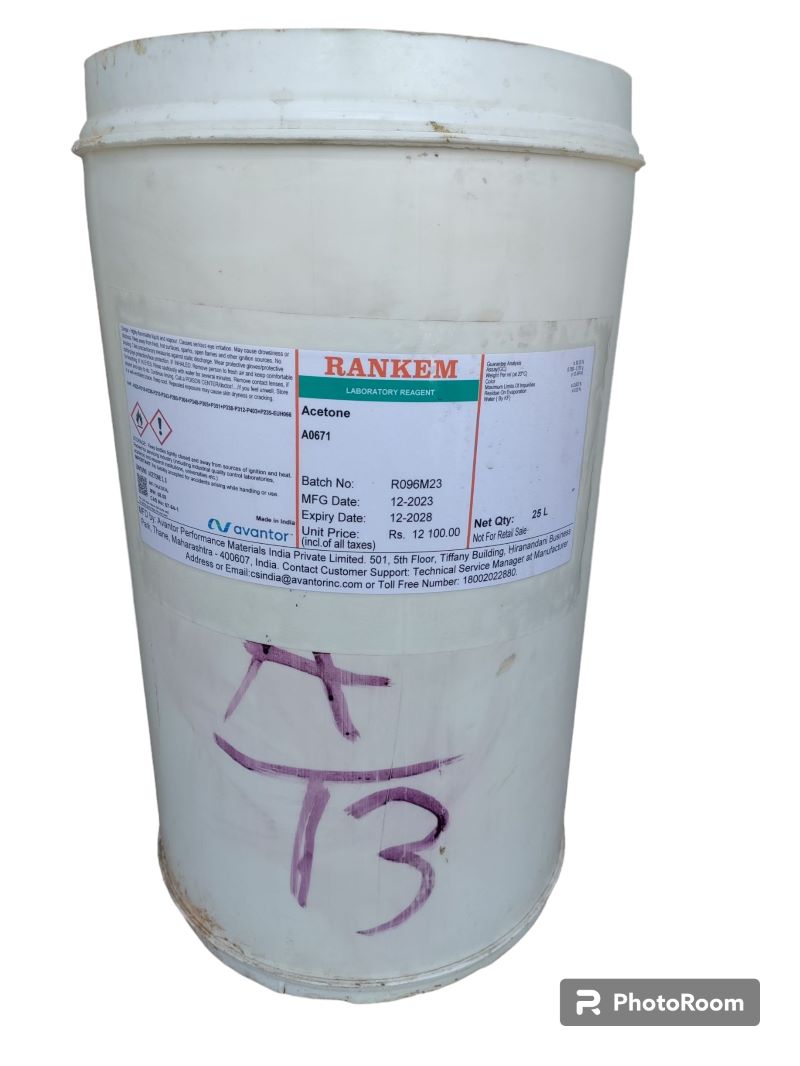Product Specification
| Purity | 99.9% |
| Purity % | > 99% |
| CAS Number | 67-64-1 |
| Packaging Details | 25 litres Drum |
| Brand | RANKEM |
| Grade Standard | LR Lab Reagent |
| Grade | LAB GRADE |
| Form | Liquid |
| Synonyms | Dimethyl Ketone,Dimethyl Carbonyl,Ketone Propane,2-propanone,beta-ketopropane |
| Density | 784 kg/m3 |
| Chemical Formula | C3H6O |
| HS Code | 29141100 |
| EC No. | 200-662-2 |
| Color | Colourless |
| Odour | pungent and floral (mint-like) |
| Shelf life | 2 to 5 years |
| Molecular Weight | 58.08 g/mol |
| Melting Point | -94.7 DegreeC |
| Solubility in water | Miscible |
| Vapor pressure | 30.6 kPa (25 DegreeC) |
| Acidity | 19.16 pKa (H2O) |
| Boiling Point | 56 Deg C |
| Refractive index | 1.3588 |
| Viscosity | 0.295 mPas |
| Flash Point | -20 DegreeC |
| Ignition Temperature | 465 DegreeC |
| Freezing Point | -95 DegreeC |
| Surface tension | 25.2 mN/m |
| Thermal Conductivity | 0.0115 W/m-K |
| Hazards | Highly flammable,causes eye irritation and dizziness |
| Precautions | Keep away from sparks/open flames/hot surfaces. Store in ventilated place. |
| ICSC Number | 87 |
| NSC Number | 135802 |
| RTECS Number | AL3150000 |
| UN Number | 1090 |
| UNII | 1364PS73AF |
| DEA Code Number | 6532 |
| FEMA Number | 3326 |
| log Kow | -0.24 |
| Henrys Law Constant | 3.50e-05 atm-m3/mole |
| Ionization Potential | 9.69 eV |
| Atmospheric OH Rate Constant | 2.19e-13 cm3/molecule*sec |
| Dissociation Constants | pKa = 20 |
| Associated Foods | Angelica, Lemon verbena, Lovage, Flaxseed, Mexican oregano, Herbal tea, Lichee, Lupine, Apple, Mango |
| Flavors | solvent, ethereal, apple, pear |
| Critical Temperature | 508.1 deg K |
| Critical Pressure | 4.7 MPa |
| Complexity | 26.3 |
| Heavy Atom Count | 4 |
| Compound Is Canonicalized | Yes |
| DSSTox Substance ID | DTXSID8021482 |
| Autoignition Temperature | 465 Deg C |
| DOT ID and Guide | 1090 127 |
| Standard Transportation Number | 49 081 05; Acetone |
Product Description
Introduction:
- Acetone is a colorless, volatile, flammable organic solvent. Acetone occurs naturally in plants, trees, forest fires, vehicle exhaust and as a breakdown product of animal fat metabolism. This agent may be normally present in very small quantities in urine and blood; larger amounts may be found in the urine and blood of diabetics. Acetone is toxic in high doses.
Uses:
- Used in small volume applications some of which are to make functional compounds such as antioxidants, herbicides, higher ketones, condensates with formaldehyde or diphenylamine, and vitamin intermediates.
- Acetone is used as a brine for low temperature heat transfer in indirect refrigeration.
- used for cleaning and drying precision parts.
- Both oil base and water base fracturing fluids are being used in the fracturing industry. Water base, which includes alcohol-water mixtures and low strength acids, make up the majority of treating fluids. The common chemicals added to these fluids are polymers for viscosity development, crosslinkers for viscosity enhancement, pH control chemicals, gel breakers for polymer degradation following the treatment, surfactants, clay stabilizers, alcohol, bactericides, fluid loss additives and friction reducer. /Hydraulic fracturing
Identifiction:
- Analytic Laboratory Methods – Method: EPA-EAD 1624; Procedure: gas chromatography/mass spectrometry; Analyte: acetone; Matrix: water; Detection Limit: 50 ug/L.
- Clinical Laboratory Methods – Method: NIOSH 8319,Issue 1; Procedure: gas chromatography with flame ionizing detector, headspace; Analyte: acetone; Matrix: urine; Detection Limit: 0.6 mg/L in pooled urine.
Safety and Hazards:
GHS Hazard Statements –
- H225: Highly Flammable liquid an d vapor[Danger Flammable liquids]
- H319: Causes serious eye irritation [Warning Serious eye damage/eye irritation]
- H336: May cause drowsiness or dizziness
Hazards Summary –
Acetone is a manufactured chemical that is also found naturally in the environment. It is a colorless liquid with a distinct smell and taste. It evaporates easily, is flammable, and dissolves in water. It is also called dimethyl ketone, 2-propanone, and beta-ketopropane. Acetone is used to make plastic, fibers, drugs, and other chemicals. It is also used to dissolve other substances. It occurs naturally in plants, trees, volcanic gases, forest fires, and as a product of the breakdown of body fat. It is present in vehicle exhaust, tobacco smoke, and landfill sites. Industrial processes contribute more acetone to the environment than natural processes.
Physical Dangers – The vapour is heavier than air and may travel along the ground; distant ignition possible.
Toxicity:
- Evidence for Carcinogenicity – not classifiable as to human carcinogenicity. BASIS FOR CLASSIFICATION: Based on lack of data concerning carcinogenicity in humans or animals.
- Exposure Routes – The substance can be absorbed into the body by inhalation, ingestion, skin and/or eye contact
- Symptoms – irritation eyes, nose, throat; headache, dizziness, central nervous system depression; dermatitis
- Inhalation Symptoms – Sore throat. Cough. Confusion. Headache. Dizziness. Drowsiness. Unconsciousness.
- Skin Symptoms – Dry skin.
- Eye Symptoms – Redness. Pain. Blurred vision.
- Ingestion Symptoms – Nausea. Vomiting.
- Target Organs – Hematological, Neurological (Nervous System)




Reviews
There are no reviews yet.